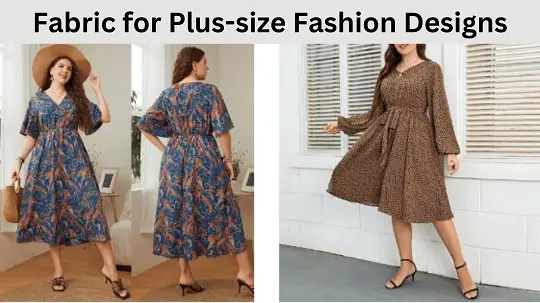Types of Fabric for Plus-size Fashion Designs
Selecting the appropriate fabric is essential for any function of clothing, but plus-size fashion design requires it much more. A curvaceous physique should be well-fitting, and comfortable, and the fabric should drape nicely. Generally, natural fibers are the best investment for plus-sized apparel fashion designs. They are easier to sew because they press well and they look and feel best on plus-sized bodies. In this article, we explain 10 Different Types of Fabric for Plus-size Fashion Designs.

10 Different Types of Fabric for Plus-size Fashion Designs
Some of the greatest materials for plus-size clothing designs are as follows:
1. Woollens and worsteds
When it comes to talking about comfort, wollen is the best. Woolens and worsteds are usually knitted or woven from the hair of sheep. They usually require dry cleaning. They are warm, absorbent, bulky, and fuzzy. For these softer fabrics, pilling, abrasion, and felting from perspiration, body warmth, and pressure can be a problem.
2. Silk :
Silk is luxurious and comfortable to wear. Filament silk is made from very long, smooth silk fibers, so it is slippery and lustrous. Raw or noil silk is made from shorter pieces of silk fiber. It is much less expensive than filament silk and feels similar to cotton. It is the most perfect fiber for fashion designs.
3. Cotton :
Cotton is comfortable and absorbent drapes well, and varies widely in quality. Generally, look for a close weave and a long fiber length. Some cotton is heavily sized or starched, to make them seem crisper, heavier, and more expensive, but of course, the sizing will wash out when the fabric is laundered or dry-cleaned. Most cottons launder well, but bright colors may fade and many cottons may require ironing.
4. Linen :
Linen fibers come from the flax plant and have been around even longer than silk. Linen is one of the favorite fibers for plus-sized designs. It is beautifully breathable and strong and wears very well. It is crisp, slightly lustrous, and luxurious. Linen fabrics vary in weight from transparent handkerchief ‘linen to heavy upholstery fabrics.
5. Synthetics :
Man-made fibers are identified by their fiber name, trade name, or the manufacturing process used to turn the basic fiber into fabric. Most synthetics were developed to replace more costly or less available natural fibers.
6. Rayon :
Rayon fabrics are strong when dry but weak when wet. They are breathable, resist abrasion, and drape attractively. They also shrink when laundered and most wrinkle very badly.
7. Acrylic :
The acrylic fibre was developed as a substitute for woolens and it is often seen in the form of knits and fleece fabrics. Acrylics are warm, bulky, fuzzy, stretchy and comfortable to wear and can be easily washed.
8. Nylon :
Nylon, also a substitute for silk, is usually slippery and very strong and drapes well, but it is also occlusive and has a very low melt temperature, so it does not take a press very well. Some of the newer types of nylon such as Taslan or Supplex are more comfortable and make excellent lightweight, windproof, and water-repellent outerwear for plus sizes.
9. Spandex :
Spandex is usually covered with other fibers such as cotton, nylon, silk, or wool fabric to produce blends for knitted and
woven fabrics.
10. Polyester :
Polyester, a.k.a. ‘The Famous Twin Sisters Polly and Esther’, is really a form of plastic made from petroleum products. Polyesters are wrinkle-resistant, durable, cheap, widely available, and attractive looking, but they do not breathe. They are extremely non-absorbent and uncomfortable to wear, especially for large, warm people.
Blends combine both the best and worst of their components’ performance characteristics. A cotton/ polyester blend, for example, may make you feel sticky and will hold oil stains, but it will not wrinkle as much as all cotton. Blends also pill more easily than single-fibre fabrics, because different fibers may pot stay twisted together and may break loose to form pills.
The weight of the fabric is an additional factor to take into account when selecting a fabric for a plus-size fashion design. In warm weather, lighter materials will drape more beautifully and feel more comfortable. Fabrics with a higher weight can offer greater support and structure, making them a useful option for clothing that has to maintain its shape in colder climates. You may build fashionable and comfy plus-size fashion designs with a vast selection of fabrics.
- You May love to read: How to Style a Denim Skirt Plus Size: A Beginner Guide
